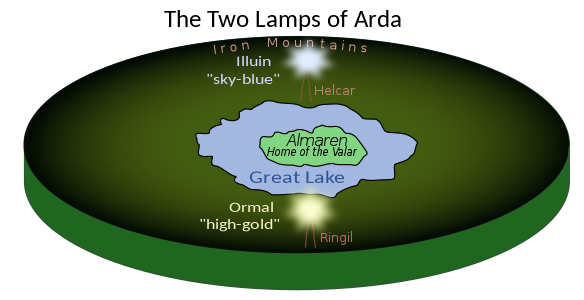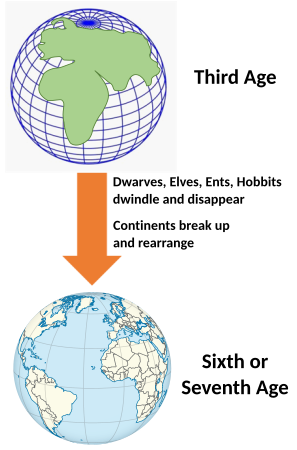The physical universe
Flat-earth cosmology
- Sketch of one of Tolkien's conceptions of Arda within the Void, Kúma, showing the Encircling Ocean, Ekkaia around the Flat Earth, Ambar, the Air, Vista, and the Starry Heaven, Ilmen, before the creation of Sun and Moon.
- Arda as a flat disc in the Years of the Lamps
Eä, "that which is", is the material universe as a realisation of the vision of the Ainur. The Quenya word is from the existential to be in its aorist form. Eä was the word spoken by Eru Ilúvatar to bring the universe into actuality. [T 2]
The Void (Kúma, the Outer Dark) is the nothingness outside Arda. From Arda, it is accessible through the Doors of Night. The Valar exiled Melkor to the Void after his defeat in the War of Wrath. Legend foretells that Melkor will return to Arda just before the apocalyptic battle of Dagor Dagorath. The void is not to be confused with the state of non-being that preceded the creation of Eä. [T 18]
When Arda (the Earth) was created, "innumerable stars" were already in existence. [T 2] To provide greater light, the Valar later created the Two Lamps in Middle-earth, and when these were destroyed they created the Two Trees of Valinor. These gave rise to the Ages of the Lamps and the Years of the Trees, however the Ages of the Stars did not conclude until the creation of the Sun. [T 19] During the Years of the Trees, shortly before the Awakening of the Elves, Varda created the Great Stars: "new stars and brighter" and constellations. [T 16]
Ilúvatar created Arda according to a flat Earth cosmology. This disc-like Arda has continents and the seas, and the moon and the stars revolve around it. Arda was created to be the "Habitation" (Ambar) for Elves and Men. [16] This world was lit by two lamps created by the Valar: Illuin ('Sky-blue') and Ormal ('High-gold'). To support the lamps, Aulë forged two enormous pillars of rock: Helcar in the north of the continent Middle-earth, and Ringil in the south. Illuin was set upon Helcar and Ormal upon Ringil. Between the columns, where the light of the lamps mingled, the Valar dwelt on the island of Almaren in the midst of a Great Lake. [T 4] When Melkor destroyed the lamps, two vast inland seas (Helcar and Ringil) and two major seas (Belegaer and the Eastern Sea) were formed, but Almaren and its lake were destroyed. [T 16] The Valar left Middle-earth, and went to the newly formed continent of Aman in the west, where they created their home called Valinor. To discourage Melkor from assailing Aman, they thrust the continent of Middle-earth to the east, thus widening Belegaer at its middle, and raising five major mountain ranges in Middle-earth: the Blue, Red, Grey, and Yellow Mountains, plus the Mountains of the Wind. This act disrupted the symmetrical shapes of the continents and seas. [T 20]
Ekkaia, also called the Enfolding Ocean and the Encircling Sea, is a dark sea that surrounds the world before the cataclysm at the end of the Second Age. During this flat-Earth period, Ekkaia flows completely around Arda, which floats on it like a ship on a sea. Above Ekkaia is a layer of atmosphere. Ulmo the Lord of Waters dwells in Ekkaia, underneath Arda. Ekkaia is extremely cold; where its waters meet the waters of the ocean Belegaer on the northwest of Middle-earth, a chasm of ice is formed: the Helcaraxë. Ekkaia cannot support any ships except the boats of Ulmo. The ships of the Númenóreans that tried to sail on it sank, drowning the sailors. The Sun passes through Ekkaia on its way around the world, warming it as it passes. [T 4] [T 21]
Ilmen is a region of clean air pervaded by light, before the cataclysm at the end of the Second Age. The stars and other celestial bodies are in this region. The Moon passes through Ilmen on its way around the world, plunging down the Chasm of Ilmen on its return. [T 21]
Spherical-earth cosmology
Tolkien's legendarium addresses the spherical Earth paradigm by depicting a catastrophic transition from a flat to a spherical world, in which Aman, the continent where Valinor lay, was removed "from the circles of the world". [3] The only remaining way to reach Aman was the so called Old Straight Road, a hidden route leaving Middle-earth's curvature through sky and space which was exclusively known and open to the Elves, who were able to navigate it with their ships. [3]
This transition from a flat to a spherical Earth is at the centre of Tolkien's "Atlantis" legend. The Númenóreans, growing arrogant, tried to reach Valinor, thinking that being there would confer immortality; but Eru destroyed their island and reshaped the world to prevent Men from ever reaching it. Tolkien's unfinished The Lost Road suggests a sketch of the idea of historical continuity connecting the Elvish mythology of the First Age with the classical Atlantis myth, the Germanic migrations, Anglo-Saxon England and the modern period, presenting the Atlantis legend in Plato and other deluge myths as a "confused" account of the story of Númenor. The cataclysmic re-shaping of the world would have left its imprint on the cultural memory and collective unconscious of humanity, and even on the genetic memory of individuals. The "Atlantis" part of the legendarium explores the theme of the memory of a 'straight road' into the West, which now only exists in memory or myth, because the physical world has been changed. [T 22] [3] The Akallabêth says that the Númenóreans who survived the catastrophe sailed as far west as they could in search of their ancient home, but their travels only brought them around the world back to their starting points. [T 23]
A few years after publishing The Lord of the Rings, in a note associated with the story "Athrabeth Finrod ah Andreth", Tolkien equated Arda with the Solar System; because Arda by this point consisted of more than one heavenly body, with Valinor on another planet, while the Sun and Moon were celestial objects in their own right. [19]
Planets and constellations

Tolkien developed a list of names and meanings called the Qenya Lexicon . Christopher Tolkien included extracts from this in an appendix to The Book of Lost Tales , with mentions of specific stars, planets, and constellations. [21] [22] The Sun was called Anor or Ur. [T 24] [T 25] The Moon was called Ithil or Silmo. [T 26] [T 27] Eärendil's Star denotes the light of a Silmaril, set on Eärendil's ship Vingilot as it flew across the sky, identified as the planet Venus. The English use of the word "earendel" in the Old English poem Christ I was found by 19th century philologists to be some sort of bright star, and from 1914 Tolkien took this to mean the morning-star; he still thought so late in his life, in 1967. [T 28] The line éala éarendel engla beorhtast "Hail, Earendel, brightest of angels" was Tolkien's inspiration. [18] Tolkien created Sindarin names for the other planets in the solar system, as recorded in Morgoth's Ring , but these were not used elsewhere. The names were Silindo for Jupiter, Carnil for Mars, Elemmire for Mercury, Luinil for Uranus, Lumbar for Saturn, and Nenar for Neptune. [T 29] The Book of Lost Tales lists Morwen as a name for Jupiter. [T 30]
A few individual stars have been identified as names of real stars, whether by Tolkien, his son Christopher, or by scholars. Tolkien indicates in "Three is Company" in The Fellowship of the Ring that Borgil is a red star which appears between Remmirath (the Pleiades) and before Menelvagor (Orion). Larsen and others write that Aldebaran is the only major red star to fit the description. [23] [20] Helluin (also Gil, Nielluin and Nierninwa) is the dog star, Sirius, while Morwinyon is Arcturus. [20]
As with the planets, a few major constellations are named in the Legendarium, and can be equated with real constellations seen in the Northern hemisphere. Eksiqilta (also Ekta) is Orion's Belt. [T 26] Menelvagor (also Daimord, Menelmacar, Mordo, Swordsman of the Sky, Taimavar, Taimondo, Telimbektar, Telimektar, Telumehtar) is Orion the hunter [20] and was meant to represent Túrin Turambar. Remmirath (also Itselokte or Sithaloth), "the Netted Stars", is the Pleiades or Seven Sisters. [20] Valacirca, "the Sickle of the Valar", [T 31] is Ursa Major (the Plough or Big Dipper) [20] which Varda set in the Northern sky as a warning to Melkor. Wilwarin, meaning "Butterfly", is taken to be Cassiopeia. [20]













